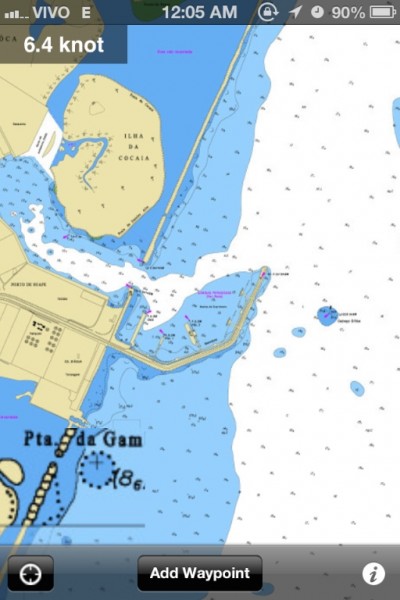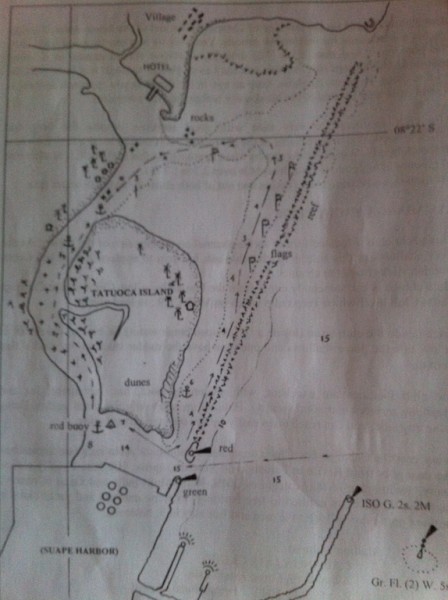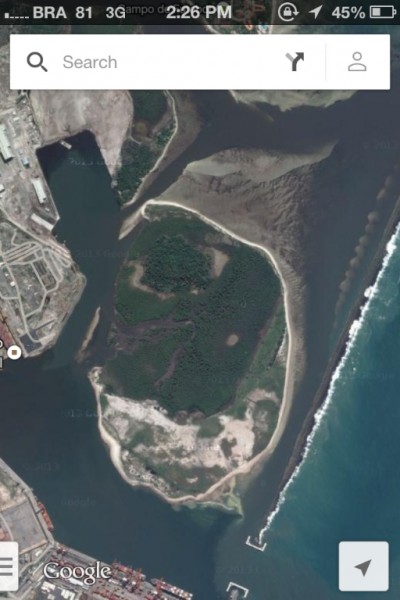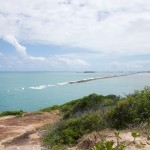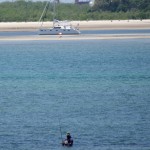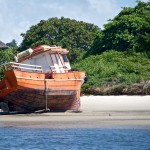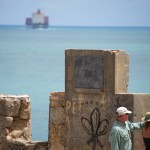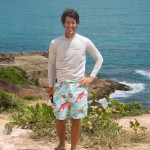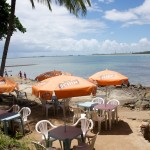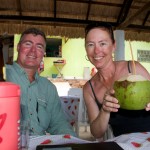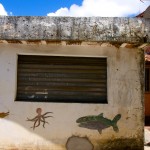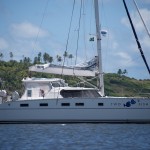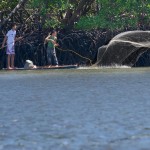Pulling one’s car into a parking space is usually pretty simple. Just steer the car between the yellow lines. Two Fish decided to “park” (anchor) in a spot which had no guiding lines; in boat-speak, that means it is uncharted.
Instead of depth readings, the chart only contains some Portuguese text that we translated to something about not having gotten around to measuring the depth.
The cruising guide write-up was appealing: great views, palm trees, nice water and calm seas. Since our fancy charting system was useless, we relied on a hand drawn map in the cruising guide. This scrawl of a chart could pose for a pirate’s treasure map. Our trust of the pirate map was a bit shaken by the misnaming of the lagoon’s primary island, but we decided to head there anyway.
After a day of light winds and bright skies we approached the harbor. The wind gods wanted to make sure the approach was difficult, so they gave us 22 knots of breeze and rain as we arrived. Of course, to add to our challenge, sunset was fast approaching and we needed light to see hazards. We also discovered that the lagoon shares an entrance with an active port that must have sprung up after the pirate map was drawn.
After avoiding a few 700-foot ships, we headed for the farther of the two entrances to the lagoon. Our treasure map had its first epic failure. The path had been replaced by a pair of huge dry docks. This fell short of our dreams of palm trees on the shore. Our spirits were buoyed when we saw a power boat head to the other entrance. The cruising guide offers this advice for the second approach: “Stay within 10 meters of the nasty boat-eating coral reef and you will find a pittance of water to pass your boat over.” We tried to follow these orders, but the violent waves crashing over the reef inspired Jason to give it more room. There is no yellow sign declaring “Reef Here” so we looked for breaking waves and black spots of rock through the dim light and rain.
To further taunt us, the cruising guide claimed that, in the late 90’s, this route was staked by flags. However, the fallible guide went on to state that no flags had been seen since 2002. There are two types of risk for the keel of Two Fish. First, sandy bottoms that are too low will trap the boat temporarily and only release on the next rising tide. This is usually benign and only requires patience.
As kids we all learned the classic children’s game of “Rock, Paper, Fiberglass.” REMEMBER ROCK BEATS FIBERGLASS. The second risk is rocks.
We used our depth sounder and our fish finder to better understand the bottom. We decided that If the depth dropped to 2 meters, we would turn back towards the reef for more water. (Two Fish swims in 1.2 meters.) Forward-looking sonar would have been nice.
Finally we saw a marker (simple white cube). We referred to this marker as a lunch box because it looked like a wayward cooler. Finally, we narrowed in on a place to drop the hook. Jason chose a spot downwind and we dropped our anchor and made adjustments. The next day, at low tide, I realized how good Jason’s choice of an anchoring spot was. Three feet away and we would certainly have grounded.
The rhythm of the tide governed the village. At 6am, the fishermen in waders walked by with their poles. Later, someone put up a beach umbrella in the now-exposed mud. We provided some entertainment for the teenage boys who challenged each other in a race to the boat and back. Later in the day, the people receded together with the sand bank and I brought up the satellite image of the mud with the dot of our lat/long. Just a step away, there was the mud. How did he do that?
While I enjoyed the view from the boat, the others headed to shore to explore the town. They missed the teenage boys racing one another from a sandbar to the edge of Two Fish and back but they had a good time anyway.
- Reef is more visible from here
- Two Fish between two sand bars
- Gave up on avoiding the mud
- Oil Tanker?
- Jason surveying the coast
- Local spot
- Chris and Erin enjoy local quaff
- Early man writing message?
- Two Fish enjoying the water
- Catch anything?
